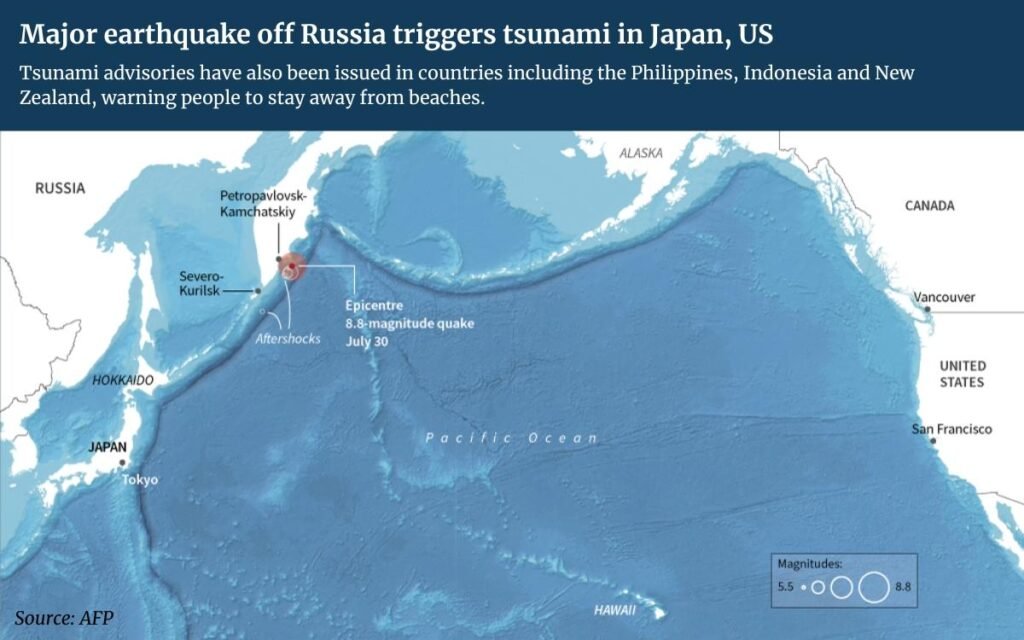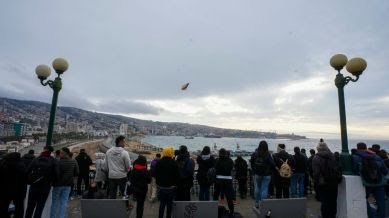One of the world’s strongest earthquakes struck Russia’s Far East early on Wednesday (July 30, 2025), an 8.8 magnitude tremble that caused a tsunami in the northern pacific region and prompted warning for Alaska, Hawaii and other coasts south toward new Zealand .
A day after the powerful earthquake, New Zealand and Chile remained on high alert, grappling with persistent tsunami warnings. New Zealand officials reported “strong and unusual currents” on their eastern coasts, attributing this to “rebounding tsunami activity from South America.” This phenomenon, where tsunami waves reflect off distant landmasses and travel back across the ocean, emphasizes the long-lasting and unpredictable nature of these events. The advisory for both the North and South Islands’ east coasts and the Chatham Islands was expected to remain in place overnight, with warnings for residents to stay clear of beaches, shorelines, and waterways. Even the West Coast of the South Island and Cook Strait, though experiencing lower-scale threats, were subject to the advisory.
Similarly, Chile, a nation highly susceptible to seismic and tsunami events, maintained a state of caution along much of its coastline. Interior Minister Alvaro Elizalde reported wave heights reaching 1.1 meters in some areas, and an alarming 2.5 meters in one location. Evacuation orders remained in effect in at-risk zones, and school closures continued, highlighting the Chilean government’s proactive approach to citizen safety. The continued alerts in New Zealand and Chile serve as a critical reminder that the immediate impact of an earthquake can evolve into a prolonged threat, demanding sustained vigilance and effective public safety measures.

While the earthquake originated thousands of kilometres away, Japan, with its extensive Pacific coastline, was not spared from the tsunami’s reach and its tragic consequences. Chief Cabinet Secretary Yoshimasa Hayashi confirmed the death of a 58-year-old woman in Mie Prefecture. Her car tragically veered off a cliff while she was evacuating to higher ground, underscoring the dangers associated with rapid evacuation efforts during a crisis. Additionally, ten people in Hokkaido were injured while rushing to shelter, and alarmingly, eleven individuals were hospitalized with heatstroke symptoms due to sheltering in extremely hot conditions, with temperatures soaring to around 40 degrees Celsius (104 Fahrenheit) in some places.
Despite these unfortunate incidents, Japan’s robust infrastructure and well-practiced disaster response protocols likely mitigated more widespread damage and casualties. The country’s swift downgrading of its last remaining tsunami alert in the north, while maintaining advisories for its Pacific coast, demonstrates its sophisticated system for assessing and responding to evolving threats.
On the opposite side of the Pacific, Crescent City, a small Californian coastal community infamous for its susceptibility to tsunamis, experienced the highest waves in the continental United States following the earthquake. Waves of up to 4 feet were recorded, a stark reminder of the 21-foot deadly waves that ravaged the city in 1964. However, this time, the “tsunami magnet” city of 6,600 was remarkably spared from major damage and injuries. While a dock at the harbor sustained some damage and warnings to avoid beaches and waterways remained, the city largely returned to routine under sunny skies. This fortunate outcome can be attributed to timely warnings, community preparedness, and perhaps the characteristics of this specific tsunami event.
Remarkably, Russia, the country nearest the earthquake’s epicenter, largely avoided major damage and serious injuries. Regional authorities in Kamchatka, often dubbed the “land of fire and ice” due to its numerous active volcanoes and frequent seismic activity, attributed this to their preparedness and swift response. The region, situated near an ocean trench where tectonic plates meet, is no stranger to earthquakes and tsunamis. The implementation of a state of emergency in some areas and rapid measures to ensure resident safety proved effective in mitigating the impact of the 8.8-magnitude quake and subsequent waves.
Adding another layer of geological activity to the scenario, Russia’s Klyuchevskoy volcano on the Kamchatka peninsula erupted shortly after the powerful earthquake. Scientists observed the “descent of burning hot lava” down the slopes of one of the world’s highest active volcanoes. While the direct causal link between the earthquake and the eruption is a subject of ongoing scientific study, the timing highlights the dynamic and often interconnected nature of geological processes in seismically active regions.

In South America, the immediate aftermath saw a mixed response to tsunami alerts. Authorities in Colombia, Ecuador, and Peru, all with Pacific coastlines, promptly dropped their tsunami warnings. Chile, however, maintained its alerts along most of its extensive coastline, reflecting a more cautious stance given its historical vulnerability. This varied response across the continent underscores the importance of localized assessments and the ongoing need for nuanced decision-making in the face of widespread natural threats.
The 8.8-magnitude earthquake off Russia’s Far East served as a powerful reminder of the interconnectedness of our planet and the far-reaching impact of natural disasters. While Russia’s preparedness helped avert a major catastrophe at the epicentre, the subsequent tsunami waves underscored the ongoing threats faced by nations across the Pacific. The varying responses in New Zealand, Chile, Japan, and the United States highlight the critical importance of robust early warning systems, comprehensive disaster preparedness, and community resilience. Tsunami danger mostly passes after earthquake hits off Russia, As our world continues to grapple with the unpredictable forces of nature, continued investment in scientific research, infrastructure, and public education remains paramount in mitigating the human and economic costs of such powerful events.
